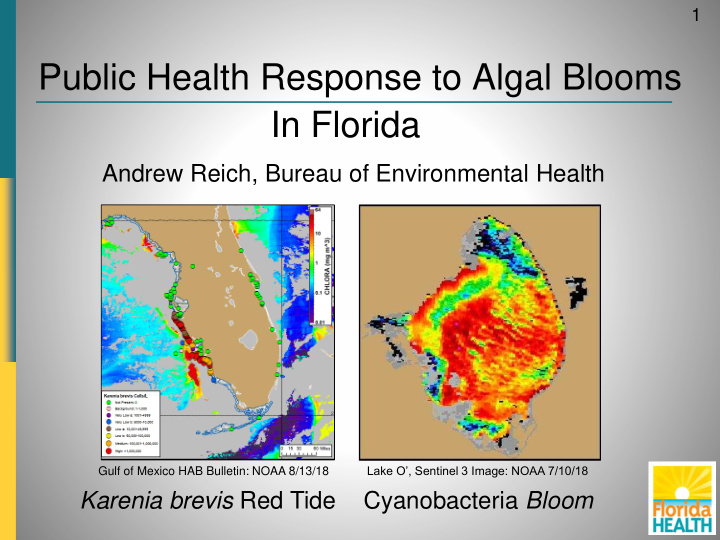



1 Public Health Response to Algal Blooms In Florida Andrew Reich, Bureau of Environmental Health Lake O’, Sentinel 3 Image: NOAA 7/10/18 Gulf of Mexico HAB Bulletin: NOAA 8/13/18 Karenia brevis Red Tide Cyanobacteria Bloom
2 Press Reports TC Palm (USA Today) 8/9/18
3 Karenia brevis Red Tide Ben Depp, National Geographic 8/8/18
4 Red Tide in Florida? floridapolitics.com WIKIMEDIA COMMONS
5 Red Tide in Florida?
6 Woods Hole Oceanographic Institution “ Other” Red Tides California. Italian Alps Hong Kong Mexico China
7 Distribution of HABs in the US Source: U.S. National Office for Marine Biotoxins and Harmful Algal Blooms
8 Freshwater: Cyanobacteria • Microcystis, Anabaena, Cylindrospermopsis Oscillatoria, Aphanizomenon News-Press (USA Today) 7/14/18 Cape Coral, Florida
9 Red Tide vs. BG algae Compare Contrast • • Single Cells Marine vs. Freshwater • • Aquatic Organisms One vs. Many Species • • Photosynthetic One vs. Many Toxins • • Produce Toxins Aerosols vs Not Airborne • • Naturally Occurring Unknown why bloom vs. • known association with Do not accumulate in nutrients fish fillets
10 Florida Red Tide Positive Samples, 1954 to Present
11 Approved Shellfish Harvesting Areas
12 Red Tide Events
13 Red Tide Events
14 Red Tide Events
15 Red Tide Events
16 Red Tide Sampling 1954 - 2013
17 NOAA Gulf of Mexico • Harmful Algal Bloom Bulletin
18 HAB Bulletin • Potential for Respiratory Irritation
19 Bubble-mediated Transport PbTx
20 Mote Marine Laboratory and Aquarium
21 Mote Marine Laboratory and Aquarium Sarasota County: Inland Transect Sampling Locations
22 Cyanobacteria/Blue-Green Algae Shepard Park on the St. Lucie River near downtown Stuart June 12, 2018. (Allen Eyestone / The Palm Chad Gillis, Fort Myers News-Press Beach Post Sept. 14, 2018
23 Cyanobacteria/Blue-Green Algae • Cyanotoxins: microcystins, anatoxins, cylindrospermosins, etc. • No taste or smell • Heat, acid stable • Toxic Rosen et al, 2017
24 Cyanobacteria Satellite Imagery National Aeronautics and Atmospheric Administration, 8/10/18
25 Lake Okeechobee Waterway
26 Signage
27 Potential Exposure Pathways Direct Skin Contact Incidental Ingestion of Ingestion Food Inhalation of Drinking Aerosols Water
28 Hydrogen Sulfide Testing
29 www.floridahealth.gov/algaeblooms
30 Health reports Emergency Department Visits
31 Health reports Florida Poison Control Exposure Calls
32 Health reports Florida Poison Control Exposure Calls
33 Department’s Web Site Cyanobacteria/Blue-Green Algae Blooms and Public Health • Some blue-green algae produce chemicals called cyanotoxins. • At high concentrations, cyanotoxins can affect the liver, nervous system and skin. • Most problems occur when substantial amounts of water containing high toxin amounts is swallowed such as when people drink untreated surface water. • Besides drinking the affected surface water, it is difficult to get cyanotoxins into the body as they do not become easily airborne and do not pass through the skin readily. • Most people avoid a blue-green algae bloom because they tend to be icky-looking and smelly.
34 Guidance What are some tips for avoiding cyanobacteria/blue- green algae? Avoid swimming in or drinking water containing blue-green algae. It is best not to come in to contact with water in areas where you see foam, scum, or mats of algae on the water. What should I do if I come in contact with cyanobacteria/blue-green algae? If you come into contact with an algae bloom, wash with soap and water. If you experience an illness, please contact your healthcare provider.
35 Department’s Web Site • Red Tide Blooms • People in coastal areas can experience varying degrees of eye, nose and throat irritation. • When a person leaves an area with a red tide, symptoms usually go away. • People with severe or chronic respiratory conditions such as asthma or chronic lung disease are cautioned to avoid areas with active red tides. • If you experience irritation, get out and thoroughly wash off with fresh water. Swimming near dead fish is not recommended. • Wearing a particle filter mask may lessen the effects, and using over-the counter antihistamines may decrease symptoms.
36 Outreach/Education
37 Dodge it
38 Outreach Cards
39 FWC Web Site http://myfwc.com/research/redtide/
40 FWC Web Site http://myfwc.com/REDTIDESTATUS
41 FDEP Web Site https://floridadep.gov/AlgalBloom
42 FDEP Web Site https://floridadep.gov/AlgalBloom
43 Contact Information andy.reich@flhealth.gov (813) 307-8015 x 5961
Recommend
More recommend